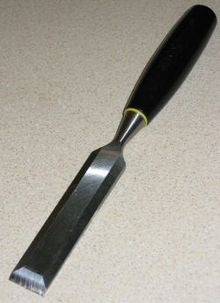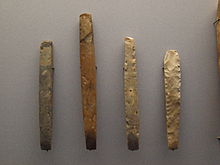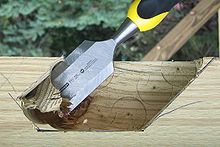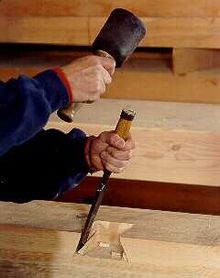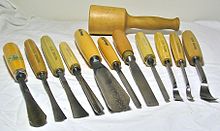- Chisel
-
This article is about the tool. For the American band, see Chisel (band). For the album by Australian band Cold Chisel, see Chisel (album).
A chisel is a tool with a characteristically shaped cutting edge (such that wood chisels have lent part of their name to a particular grind) of blade on its end, for carving or cutting a hard material such as wood, stone, or metal. The handle and blade of some types of chisel are made of metal or wood with a sharp edge in it.
In use, the chisel is forced into the material to cut it. The driving force may be manually applied or applied using a mallet or hammer. In industrial use, a hydraulic ram or falling weight ('trip hammer') drives the chisel into the material to be cut.
A gouge, one type of chisel, is used, particularly in woodworking, woodturning and sculpture, to carve small pieces from the material. Gouges are most often used in creating concave surfaces. A gouge typically has a 'U'-shaped cross-section.
Contents
Use
Chisels have a wide variety of uses. Many types of chisels have been devised, each specially suited to its intended use. Different types of chisels may be constructed quite differently, in terms of blade width or length, as well as shape and hardness of blade. They may have wooden handles attached or may be made entirely of one piece of metal.
Woodworking
Woodworking chisels range from small hand tools for tiny details, to large chisels used to remove big sections of wood, in 'roughing out' the shape of a pattern or design. Typically, in woodcarving, one starts with a larger tool, and gradually progresses to smaller tools to finish the detail. One of the largest types of chisel is the slick, used in timber frame construction and wooden shipbuilding. There are many types of woodworking chisels used for specific purposes, such as:
- butt chisel: short chisel with beveled sides and straight edge for creating joints.
- carving chisels: used for intricate designs and sculpting; cutting edges are many; such as gouge, skew, parting, straight, paring, and V-groove.
- corner chisel: resembles a punch and has an L-shaped cutting edge. Cleans out square holes, mortises and corners with 90 degree angles.
- bevel edge chisel: can get in acute angles with its bevel edges.
- flooring chisel: cuts and lifts flooring materials for removal and repair; ideal for tongue-and-groove flooring.
- framing chisel: usually used with mallet; similar to a butt chisel, except it has a longer, slightly flexible blade.
- slick: a large chisel driven by manual pressure, never struck.
- mortise chisel: thick, rigid blade with straight cutting edge and deep, slightly tapered sides to make mortises and similar joints.
- paring chisel: has a long blade which is ideal for cleaning grooves and accessing tight spaces.
- skew chisel: has a 60 degree cutting angle and is used for trimming and finishing.
- dovetail chisel: Made specifically for cutting dovetail joints. The difference being the thickness of the body of the chisel, as well as the angle of the edges, permitting easier access to the joint.
Lathe tools
A lathe tool is a woodworking chisel designed to cut wood as it is spun on a lathe. These tools have longer handles for more leverage, needed to counteract the tendency of the tool to react to the downward force of the spinning wood being cut or carved. In addition, the angle and method of sharpening is different; a secondary bevel would not be ground on the tool.
Metalworking
Chisels used in metal work can be divided into two main categories: hot chisels and cold chisels.
Cold chisel
A cold chisel is a tool made of tempered steel used for cutting 'cold' metals, meaning that they are not used in conjunction with heating torches, forges, etc. Cold chisels are used to remove waste metal when a very smooth finish is not required or when the work cannot be done easily with other tools, such as a hacksaw, file, bench shears or power tools.
The name cold chisel comes from its use by blacksmiths to cut metal while it was cold as compared to other tools they used to cut hot metal. This tool is also commonly referred to by the misnomer coal chisel. Because cold chisels are used to form metal, they have a less-acute angle to the sharp portion of the blade than a woodworking chisel. This gives the cutting edge greater strength at the expense of sharpness.
Cold chisels come in a variety of sizes, from fine engraving tools that are tapped with very light hammers, to massive tools that are driven with sledgehammers. Cold chisels are forged to shape and hardened and tempered (to a blue colour) at the cutting edge.
The head of the chisel is chamfered to slow down the formation of the mushroom shape caused by hammering and is left soft to withstand hammer blows.
There are four common types of cold chisel. These are the flat chisel, the most widely known type, which is used to cut bars and rods to reduce surfaces and to cut sheet metal which is too thick or difficult to cut with tin snips. The cross cut chisel is used for cutting grooves and slots. The blade narrows behind the cutting edge to provide clearance. The round nose chisel is used for cutting semi-circular grooves for oil ways in bearings. The diamond point chisel is used for cleaning out corners or difficult places and pulling over centre punch marks wrongly placed for drilling. Although the vast majority of cold chisels are made of steel, a few are manufactured from beryllium copper, for use in special situations where non-sparking tools are required.
Hot chisel
A hot chisel is used to cut metal that has been heated in a forge to soften the metal. One type of hot chisel is the "hardy chisel", which is used in an anvil hardy hole with the cutting edge oriented up. The hot workpiece cut is then placed over the chisel and struck with a hammer. The hammer drives the workpiece into the chisel, which allows it to be snapped off with a pair of tongs.
Stone
Stone chisels are used to carve or cut stone, bricks or concrete slabs. To cut, as opposed to carve, a brick bolster is used; this has a wide, flat blade that is tapped along the cut line to produce a groove, then hit hard in the centre to crack the stone. Sculptors use a spoon chisel, which is bent, with the bezel (cutting edge) on both sides. To increase the force, stone chisels are often hit with club hammers, a heavier type of hammer.
Masonry
Masonry chisels are typically heavy, with a relatively dull head that wedges and breaks, rather than cuts. Normally used as a demolition tool, they may be mounted on a hammer drill, jack hammer, or hammered manually, usually with a heavy hammer of three pounds or more.
A plugging chisel has a tapered edge for cleaning out hardened mortar. The chisel is held with one hand and struck with a hammer. The direction of the taper in the blade determines if the chisel cuts deep or runs shallow along the joint.
Gouge
A modern gouge is similar to a chisel except its blade edge is not flat, but instead is curved or angled in cross-section. The modern version is generally hafted inline, the blade and handle typically having the same long axis. If the angle of the plane of the blade is on the outer surface of the curve the gouge is called an 'incannel' gouge, otherwise it is known as an 'outcannel' gouge. Gouges with angled rather than curved blades are often called 'V-gouges' or 'vee-parting tools'. Variations include 'crank-neck' gouges, 'spoon-bent' gouges, etc. Gouges are used in wood working and arts. For example, a violin luthier will use a gouge to carve the violin, a craftsmen may use it to scoop out wood for a project, or an artist may produce a piece of art by cutting some bits out of a sheet of linoleum (see also Linocut).
See also
References
- Reader's Digest Book of Skills & Tools ISBN 0-89577-469-0
Stonemasonry Types Materials List of stone • Artificial stone • Brick • Cast stone • Decorative stones • Dimension stone • Fieldstone • Flagstone • Gabions • Granite • Marble • Mortar • Sandstone • SlateTools Angle grinder • Bush hammer • Ceramic tile cutter • Chisel • Diamond blade • Lewis (lifting appliance) • Non-explosive demolition agents • Plug and feather • Stonemason's hammer • StraightedgeTechniques Products Organizations Metalworking Tools Cutting machines Cutting tools Broach · Burr · Chisel · Counterbore · Countersink · End mill · File · Hand scraper · Milling cutter · Nibbler · Reamer · Shears · Tipped tool · Tool bitForming tools Brake · Die · English Wheel · Hydraulic press · Machine press · Punch press · Screw press · Stamping pressHand tools Clamp · Combination square · Drift pin · File · Hacksaw · Hammer · Hand scraper · Machinist square · Needlegun scaler · Piercing saw · Pliers · Punch · Scriber · Tap and die · Tongs · Vise · Workbench · WrenchMachine tooling Angle plate · Chuck · Collet · Jig · Fixture · Indexing head · Lathe center · Machine taper · Magnetic base · Mandrel · Rotary table · WigglerMeasuring instruments Bore gauge · Caliper · Center gauge · Comparator · Dial indicator · Engineer's blue · Feeler · Gauge · Gauge block · Go/no go gauge · Height gauge · Machinist square · Marking blue · Marking gauge · Marking out · Micrometer · Radius gauge · Scale · Sine bar · Spirit level · Straightedge · Surface plate · Tape measure · Thread pitch · Vernier scaleSmithing tools Casting · Fabrication · Forming · Jewellery · Machining · Metallurgy · Smithing · Tools and terminology · Welding Categories:- Chisels
Wikimedia Foundation. 2010.

